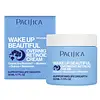What's inside
What's inside
 Key Ingredients
Key Ingredients

 Benefits
Benefits

 Concerns
Concerns

 Ingredients Side-by-side
Ingredients Side-by-side

Water
Skin ConditioningHelianthus Annuus Seed Oil
EmollientGlycerin
HumectantSr-Hydrozoan Polypeptide-1
HumectantCetyl Esters
EmollientGlyceryl Stearate
EmollientCetyl Alcohol
EmollientStearyl Alcohol
EmollientStearic Acid
CleansingTocopheryl Acetate
AntioxidantDiheptyl Succinate
EmollientCapryloyl Glycerin/Sebacic Acid Copolymer
Skin ConditioningMagnesium Ascorbyl Phosphate
AntioxidantCitrus Aurantium Dulcis Flower Extract
Skin ConditioningJasminum Officinale Extract
MaskingChamomilla Recutita Flower Extract
MaskingArnica Montana Extract
Skin ConditioningAllantoin
Skin ConditioningDipotassium Glycyrrhizate
HumectantXanthan Gum
EmulsifyingPhenoxyethanol
PreservativeEthylhexylglycerin
Skin ConditioningParfum
MaskingWater, Helianthus Annuus Seed Oil, Glycerin, Sr-Hydrozoan Polypeptide-1, Cetyl Esters, Glyceryl Stearate, Cetyl Alcohol, Stearyl Alcohol, Stearic Acid, Tocopheryl Acetate, Diheptyl Succinate, Capryloyl Glycerin/Sebacic Acid Copolymer, Magnesium Ascorbyl Phosphate, Citrus Aurantium Dulcis Flower Extract, Jasminum Officinale Extract, Chamomilla Recutita Flower Extract, Arnica Montana Extract, Allantoin, Dipotassium Glycyrrhizate, Xanthan Gum, Phenoxyethanol, Ethylhexylglycerin, Parfum
Water
Skin ConditioningGlyceryl Stearate Se
EmulsifyingGlycerin
HumectantHelianthus Annuus Seed Oil
EmollientCoco-Caprylate/Caprate
EmollientCetyl Esters
EmollientHydroxypinacolone Retinoate
Skin ConditioningInonotus Obliquus Extract
Skin ConditioningMelatonin
AntioxidantChenopodium Quinoa Seed Oil
EmollientRosa Damascena Flower Water
MaskingCitrus Aurantium Amara Flower Extract
RefreshingJasminum Officinale Flower Extract
MaskingLavandula Angustifolia Flower Extract
CleansingRose Extract
Skin ConditioningPaeonia Officinalis Flower Extract
TonicPrunus Serrulata Flower Extract
Skin ConditioningSambucus Nigra Flower Extract
RefreshingRosa Damascena Flower Oil
MaskingTocopherol
AntioxidantCaprylic/Capric Triglyceride
MaskingDimethyl Isosorbide
SolventSclerotium Gum
Emulsion StabilisingPotassium Sorbate
PreservativeSodium Benzoate
MaskingCitric Acid
BufferingPhenoxyethanol
PreservativeEthylhexylglycerin
Skin ConditioningWater, Glyceryl Stearate Se, Glycerin, Helianthus Annuus Seed Oil, Coco-Caprylate/Caprate, Cetyl Esters, Hydroxypinacolone Retinoate, Inonotus Obliquus Extract, Melatonin, Chenopodium Quinoa Seed Oil, Rosa Damascena Flower Water, Citrus Aurantium Amara Flower Extract, Jasminum Officinale Flower Extract, Lavandula Angustifolia Flower Extract, Rose Extract, Paeonia Officinalis Flower Extract, Prunus Serrulata Flower Extract, Sambucus Nigra Flower Extract, Rosa Damascena Flower Oil, Tocopherol, Caprylic/Capric Triglyceride, Dimethyl Isosorbide, Sclerotium Gum, Potassium Sorbate, Sodium Benzoate, Citric Acid, Phenoxyethanol, Ethylhexylglycerin
Ingredients Explained
These ingredients are found in both products.
Ingredients higher up in an ingredient list are typically present in a larger amount.
Cetyl Esters is a synthetic wax made up of mostly fatty acids and fatty alcohols. It is strcturally similar to wax taken from whales.
As an emollient, it creates a thin barrier on the skin. This barrier prevents moisture from escaping.
This ingredient may not be fungal-acne safe.
Learn more about Cetyl EstersEthylhexylglycerin (we can't pronounce this either) is commonly used as a preservative and skin softener. It is derived from glyceryl.
You might see Ethylhexylglycerin often paired with other preservatives such as phenoxyethanol. Ethylhexylglycerin has been found to increase the effectiveness of these other preservatives.
Glycerin is already naturally found in your skin. It helps moisturize and protect your skin.
A study from 2016 found glycerin to be more effective as a humectant than AHAs and hyaluronic acid.
As a humectant, it helps the skin stay hydrated by pulling moisture to your skin. The low molecular weight of glycerin allows it to pull moisture into the deeper layers of your skin.
Hydrated skin improves your skin barrier; Your skin barrier helps protect against irritants and bacteria.
Glycerin has also been found to have antimicrobial and antiviral properties. Due to these properties, glycerin is often used in wound and burn treatments.
In cosmetics, glycerin is usually derived from plants such as soybean or palm. However, it can also be sourced from animals, such as tallow or animal fat.
This ingredient is organic, colorless, odorless, and non-toxic.
Glycerin is the name for this ingredient in American English. British English uses Glycerol/Glycerine.
Learn more about GlycerinHelianthus Annuus Seed Oil is the oil derived from the seeds of a Sunflower. Sunflower seed oil is non-fragrant. It is an emollient, meaning it helps to soften the skin.
Sunflower seed oil contains many fatty acids. The fatty acids found in sunflower seeds include (from highest amount to least): linoleic acid, myristic acid, palmitic acid, stearic acid, arachidic acid, oleic acid, and linolenic acid.
These fatty acids help the skin create ceramides. Ceramides play a role in repairing the skin barrier.
Helianthus Annuus Seed Oil helps moisturize the skin. This in turn helps the skin look more rejuvenated and smoother.
Sunflowers are rich in vitamin E.
Historians believe Indigenous cultures of North America domesticated sunflowers before corn. Thus they relied on sunflower oil for a variety of uses. One such use is moisturizing skin and hair.
Sunflower seed oil may not be fungal acne safe. We recommend speaking with a professional if you have any concerns.
Learn more about Helianthus Annuus Seed OilPhenoxyethanol is a preservative that has germicide, antimicrobial, and aromatic properties. Studies show that phenoxyethanol can prevent microbial growth. By itself, it has a scent that is similar to that of a rose.
It's often used in formulations along with Caprylyl Glycol to preserve the shelf life of products.
Water. It's the most common cosmetic ingredient of all. You'll usually see it at the top of ingredient lists, meaning that it makes up the largest part of the product.
So why is it so popular? Water most often acts as a solvent - this means that it helps dissolve other ingredients into the formulation.
You'll also recognize water as that liquid we all need to stay alive. If you see this, drink a glass of water. Stay hydrated!
Learn more about Water